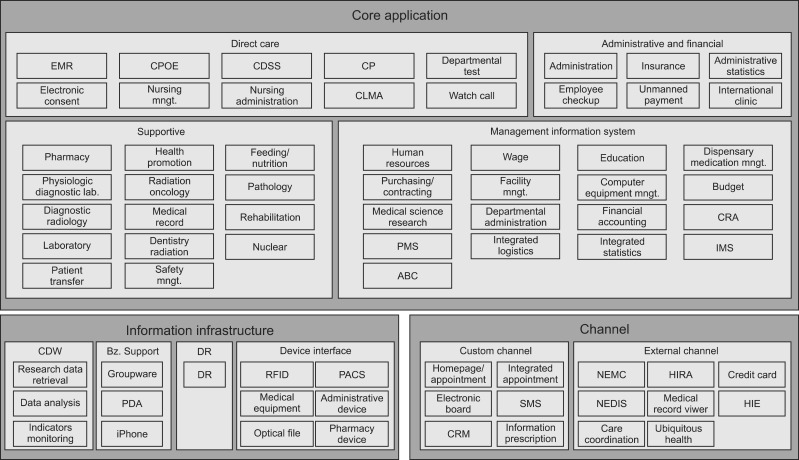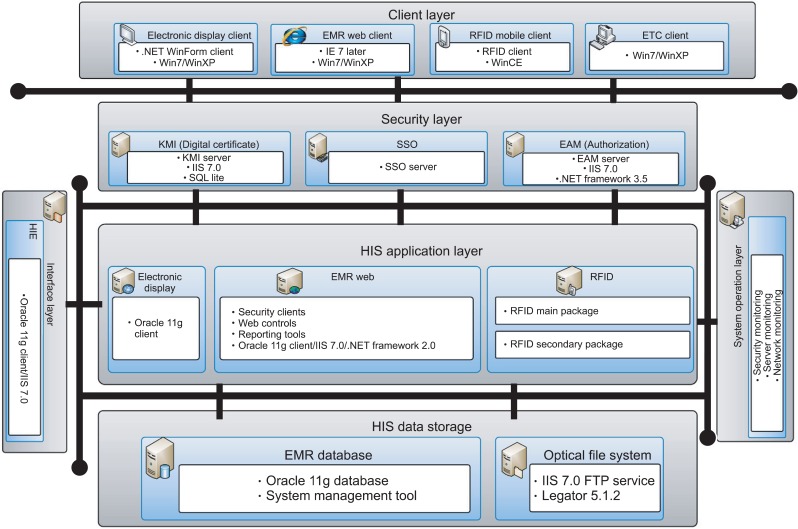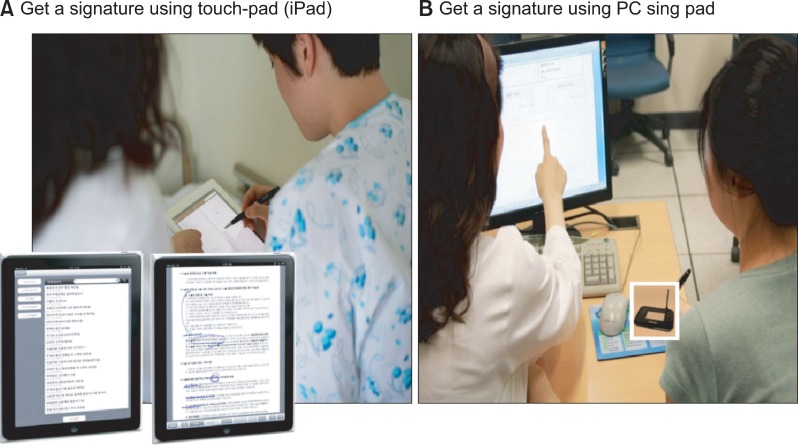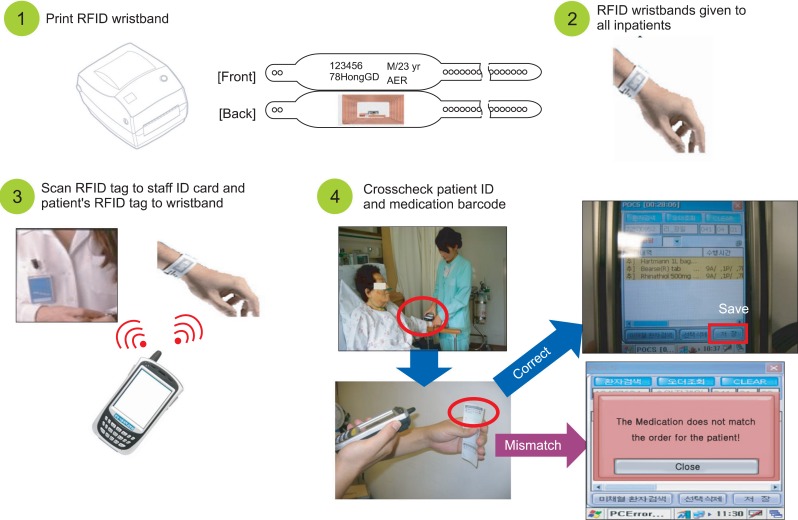Seoul National University Bundang Hospital's Electronic System for Total Care
Article information
Abstract
Objectives
Seoul National University Bundang Hospital, which is the first Stage 7 hospital outside of North America, has adopted and utilized an innovative and emerging information technology system to improve the efficiency and quality of patient care. The objective of this paper is to briefly introduce the major components of the SNUBH information system and to describe our progress toward a next-generation hospital information system (HIS).
Methods
SNUBH opened in 2003 as a fully digital hospital by successfully launching a new HIS named BESTCare, "Bundang hospital Electronic System for Total Care". Subsequently, the system has been continuously improved with new applications, including close-loop medication administration (CLMA), clinical data warehouse (CDW), health information exchange (HIE), and disaster recovery (DR), which have resulted in the achievement of Stage 7 status.
Results
The BESTCare system is an integrated system for a university hospital setting. BESTCare is mainly composed of three application domains: the core applications, an information infrastructure, and channel domains. The most critical and unique applications of the system, such as the electronic medical record (EMR), computerized physician order entry (CPOE), clinical decision support system (CDSS), CLMA, CDW, HIE, and DR applications, are described in detail.
Conclusions
Beyond our achievement of Stage 7 hospital status, we are currently developing a next-generation HIS with new goals of implementing infrastructure that is flexible and innovative, implementing a patient-centered system, and strengthening the IT capability to maximize the hospital value.
I. Introduction
The adoption of healthcare information technology can facilitate improved efficiency and enhanced quality while reducing resource utilization and unnecessary treatment [1,2]. The Institute of Medicine (IOM) has defined a set of eight core functions of an electronic health record (EHR): health information and data management, results management, order management, decision support, electronic communication and connectivity, patient support administrative processes and reporting, and population health reporting. The IOM suggests that an EHR include a portion of a patient's computerized medical records and specifies the functional benefits derived from having an EHR [3]. Seoul National University Bundang Hospital (SNUBH) has adopted a new and innovative health information technology and implemented those functionalities designed to improve the efficiency and quality of patient care.
SNUBH is a public tertiary general hospital located in the Seoul metropolitan area (Seongnam City, Gyeonggi-do, South Korea); it opened in May 2003 as the first fully digitalized general hospital in the world. SNUBH is equipped with 8 specialized centers and 23 clinical departments and has 910 beds and approximately 4,000 outpatient visits per day. The hospital is staffed by physicians from Seoul National University's College of Medicine, and approximately 542 doctors, 919 nurses, and 277 staff members are employed.
In 2001, SNUBH started the development of an electronic medical record (EMR) system with the mission of opening a fully digitalized hospital. After 22 months of system development, SNUBH successfully launched a new hospital information system named BESTCare, "Bundang hospital Electronic System for Total Care", when the hospital was opened. The system was then successfully deployed to Seoul National University Hospital (SNUH), which is our principal hospital, through a customization process [4]. Because of the continuing adoption of information technology, in October 2010, SNUBH was accredited as having a Stage 7 comprehensive EHR system by the Healthcare Information and Management Systems Society (HIMSS) Analytics™ Electronic Medical Record Adoption Model (EMRAM), which was the first Stage 7 accreditation outside of the North America [5]. HIMSS Analytics™ EMRAM evaluates the state of information technology (IT) implementation of a hospital based on eight levels (0 to 7) of EMR capabilities ranging from limited ancillary department systems to a paperless EMR environment [1].
This paper briefly describes the major components and features of the BESTCare system.
II. Case Description
1. History of IT Adoption and Development
After opening in 2003 as a fully digitalized hospital with 609 beds, SNUBH expanded to 909 beds in 2004. In 2005, a clinical data warehouse (CDW) system was developed to provide data retrieval and analysis to end-users. The first ubiquitous health (u-health) research project was initiated to provide glucose and ECG monitors to the elderly people living in a silver town near SNUBH and to tele-monitor their bio-signal results in our u-health center. In 2006, SNUBH participated in the Korea's national interoperable EHR initiative project and realized a health information exchange (HIE) with nearby network clinics. Subsequently, in 2008, real-time resource management using barcoding and radio frequency identification (RFID) was developed and applied to track medication delivery and logistics. Emerging smartphone-based mobile computing and cloud-based desktop virtualization technologies were adopted to become ubiquitous throughout the hospital. SNUBH has been developing a next-generation HIS since 2011. Table 1 presents a brief history of the adoption of new IT systems at SNUBH.
2. IT Team Organization
SNUBH has been establishing IT strategies and managing information systems through a medical information steering committee and the center for medical informatics under the chief information officer (CIO). The center for medical informatics has the medical record management committee, the u-healthcare center, several HIS operating task force teams (TFTs), and a medical information team. At SNUBH, the HIS operating TFTs include the EMR, security, HIE, CDSS, and standardization TFTs that make operational polices and decisions for changes in information systems to control the quality of system. The medical information team is divided into the information strategic planning, EMR coordination, transcriptionist, medical record management, and research and development teams. The information systems are maintained by an outsourced vendor.
3. Applications of BESTCare System
The BESTCare system is an all-in-one system that integrates the outpatient, inpatient, intensive care unit, emergency room, and operating room units. BESTCare is a web-based system using Internet Explorer and .NET applications and is a single sign-on system. BESTCare is mainly composed of three application domains, i.e., the core application, information infrastructure, and channel domain, as shown in Figure 1. First, the core application domain of the system includes applications related to clinical and administrative activities; applications can be grouped as direct care, support, administrative and financial, and management information system (MIS) applications. Second, the information infrastructure domain of the system includes applications that support data retrieval and analysis, back-up, and diverse devices and interfaces, such as CDW, disaster recovery (DR), groupware, and an interface to picture archiving and communication system (PACS). Third, the channel domain includes applications for communicating with patients and integrating with systems outside of SNUBH, including, homepages, customer relationship management (CRM), and HIE.

Applications of Bundang hospital Electronic System for Total Care (BESTCare) system. ABC: activity-based costing, Bz: business, CDSS: clinical decision support system, CDW: clinical data warehouse, CLMA: closed loop medication administration, CP: clinical pathway, CPOE: computerized physician order entry, CRA: Clinical Research Associate, CRM: custom relation management, DR: disaster recovery, EMR: electronic medical records, HIE: health information exchange, HIRA: Health Insurance Review & Assessment Service, IMS: integrated management system, Mngt: management, NEDIS: National Emergency Department Information System. NEMC: National Emergency Medical Center, PACS: picture archiving and communication system, PDA: personal device assistant, PMS: practice management system, RFID: radio frequency identification, SMS: short message service.
Figure 2 shows the system structure of the BESTCare system which consists of several layers: HIS data storage, HIS application, security, client, system operation, and interface layers.

System architecture of Bundang hospital Electronic System for Total Care (BESTCare) system. EAM: enterprise authorization management, EMR: electronic medical records, HIE: health information exchange, HIS: hospital information system, KMI: key management infrastructure, RFID: radio frequency identification, SSO: single sign-on.
In the Results section, we described the most unique features of the EMR/CPOE, CDSS, CLMA, CDW, HIE, and DR systems in further detail.
III. Results
1. Electronic Medical Record/Computerized Physician Order Entry
The user interface of the BESTCare system was based on dual 17-inch monitors where patient information, data retrieval, and data input areas, were positioned on a left-side monitor, and an order entry area was positioned on a right-side monitor. The user interface was chronologically structured to use a historical perspective of past and present items to future events that occur during patient care (Figure 3).
Using the EMR and CPOE applications, 100% of all medical orders and documentations were electronically entered and managed. At SNUBH, all physicians' and nurses' documentations were completed using structured templates. Questionnaires and outside documents, such as referrals, were the only paper documents that were produced. These documents were all scanned into the EMR. To improve the process of obtaining patient consent and to reduce the cost of keeping consent papers, we recently transformed a paper consent form to an electronic form by developing an electronic consent system that supports patients' signatures on an iPad or a PC signature pad (Figure 4). The electronic consent system was one of the distinguishing features of our EMR system.

Electronic consent system that provides electronic consent forms and gets patient's signature using iPad (A) or PC sign pad (B).
The various types of documentation templates were classified into common templates that were shared by all departments, including outpatient admission notes and discharge summaries, and departmental templates that were created by each sub-specialty and department, including departmental and specialized tests, for example. The number of templates has increased annually. When SNUBH first opened in 2003, there were 1,533 common templates and 405 departmental templates. By 2011, the total number of common and departmental templates had increased to 1,989 and 1,269, respectively. From 2003 to 2011, the average annual increase in the number of common and documental templates was 3.3% and 15.3%, respectively. It appears that end-users have a continuous need for the creation of new templates for various clinical and research activities.
The use of a controlled terminology for documentation would be very important with respect to semantic interoperability and data utilization. In our template-based documentation system, our local medical terms were mapped to standard vocabularies, mainly comprising the Systematized Nomenclature of Medicine Clinical Terms (SNOMED CT). Currently, chief complaints, diagnoses, operative procedures, nursing terms, drug, and test observation names were mapped to appropriate standard terminologies, such as the SNOMED CT International Classification of Disease (ICD)-10, International Classification for Nursing Practice (ICNP), WHO Anatomical Therapeutic Chemical (ATC), and Logical Observation Identifiers Names and Codes (LOINC) datasets. The standardized terms were used to drive the clinical decision support systems and were used when retrieving and analyzing data on our CDW.
2. Clinical Decision Support System
To improve patient safety and quality of care, diverse types of CDSS were developed and integrated with CPOE. To reduce medication errors due to order entry, we developed the following alerts: drug dosage and range; drug-drug interaction; drug-allergy interaction; contraindication rules according to age, combination, child, pregnancy, and breast feeding; duplicated orders; and renal dosing. Clinical guidelines for physicians regarding antibiotic and anti-cancer medications and transfusions were developed. Nursing medication cautions and a medication dosage calculator were provided to the nurses. An alert system regarding the side effects of contrast agents was developed for the examination room. A drug database was created and periodically updated to provide detailed drug information and guidelines.
The clinical pathway (CP) application was developed to improve patient safety and reduce hospital stays through a standardized process of patient care. CP is a multidisciplinary management tool that provides the desired steps of diagnostic and treatment measures to be performed on a specific group of patients for each day of treatment [6]. At SNUBH, CP guidelines were implemented through the following processes: the development of a basic clinical guideline by a department, the implementation of a pilot study of target patients, the development of a CP program, the verification and revision of the CP based on user feedback, and final adjustments. Currently, 11 departments are using 104 CPs, including those for cesarean section, thyroidectomy, and osteotomy.
3. Closed Loop Medication Administration
Using barcodes and RFID, we implemented a CLMA system that ensures the five "rights" of medication administration - the right patient, right drug, right dose, right route, and right time.
In the pharmacy, unit dose medications were automatically barcoded by an automatic tablet counter (ATC) machine according to the physician's order information. Using the drug delivery tracking system, containers with RFID tags containing the barcoded medication were automatically delivered from the pharmacy to the relevant wards. As shown in Figure 5, all inpatients were given a wristband with an RFID tag. Within a ward, nurses used a PDA to scan both the patient's wristband RFID tag and the barcode on the respective medication to confirm the five rights before administering medications. By matching the medication and patient with the physicians' order information, the PDA program verified the administration process. Using this system, real-time data were saved into the EMR system, and if the medication did not match the order for the patient, an alert message prevented administration errors. This system has the advantages of reducing the nurse's workload by avoiding the need to record medication administrations and improving patient safety by reducing preventable administration errors.
4. Clinical Data Warehouse
A CDW was developed to meet the needs for the utilization of electronic records in further data analysis and index monitoring for both patient care and research purposes. To ensure that the CDW application did not to affect the performance of the operational system, we created separate CDW database. The patient information, medical records, nursing records, order information, financial information and test information data were updated from the operation database to the CDW daily using an extraction, transformation, and load (ETL) process. Authorized users were then allowed to access the data warehouse. Online analytical processing (OLAP) was used to develop functions to search data using a set of ad-hoc query keywords and track various indexes, including the quality of care, quality of medical records, and customer satisfaction. By proving links from the CDW to the EMR, we allowed users to quickly read and check a full medical record of a patient using the EMR application based on the search results.
Using the CDW, we have maintained several clinical indicators that can be classified into common, departmental, and other nursing/pharmacy/nutrition related indicators. For example, we periodically monitored the CPR survival rate and the number of days that antibiotics used for postoperative care to improve patient safety. Of the 290 clinical indicators, 248 were electronically implemented as of February 2012. These indicators have been utilized for quality assurance activities at our hospital.
5. Health Information Exchange
We implemented HIE environments between SNUBH and private clinics near SNUBH to provide online ambulatory refer/reply, emergency room refer/reply and walk-in services. International standards, including Health Level 7 (HL7) V2.X messaging and HL7 Clinical Document Architecture (CDA), were used for interoperable HIE with heterogeneous EMR applications. The overall architecture and technical implementation method was described in [7].
As of January 2012, 36 private network clinics participated in our HIE. A total of 8,507 patients have been participating in the HIE and agreed to share their information between SNUBH and a local clinic. Since the initiation of the HIE in June 2008, the number of participating patients has steadily increased, thereby indicating the successful adoption of HIE in our hospital.
6. Disaster Recovery
At SNUBH, a DR system was implemented for five months from July 16, 2011, to November 15, 2011. To maintain business/care continuity and data safety even in the case of a system failure and unexpected disaster, a DR system was implemented for the main HIS database as well as the EMR/CPOE/MIS applications, optical file, and device interfaces. The database was backed up to the DR system in real time using FC cables between the main center and the DR center. Through the use of periodic field tests, we strive to establish an enterprise-wide emergency response system.
IV. Discussion
We have increased the utilization of information technology to improve the quality of patient care. At SNUBH, RFID and barcoding have been widely utilized to improve patient safety, resource management, and workflow management, including medication returns, patient management, food/nutrition management, asset management, blood sample tracking, blood transfusion management, and drug delivery tracking as well as medical administration. There is evidence that CLMA systems that use RFID and barcoding have led to reductions in medication administration errors [8-10], thereby demonstrating the meaningful use of information technology in healthcare.
SNUBH established the complete EHR system by phasing in the implementation of new information technologies and information systems over several years. The phase-in implementation was conducted in accordance with our information strategy plan that was periodically established by taking into considerations emerging trends in information technology, resources, and integration with legacy systems. When determining the adoption of a new technology and system, technical issues, such as technology feasibility, interoperability, standards, integration with legacy systems, and security, were first thoroughly checked and solved before their implementation. The implementation was then conducted with a pilot project, and the system was integrated into enterprise-wide system after completing verification and validation. During the system implementation, issues such as clarification of user requirements and establishment of operational polices were resolved. Evaluation of the new system was considered from various points of view such as financial and clinical outcome assessments.
The investment in and adoption of advanced information technology in a hospital required strong leadership and support from an executive board. Strong leadership was one of the key factors in the successful adoption of information technology at SNUBH. The driving forces of innovative information technologies, including a virtual desktop infrastructure (VDI), mobile EMR, and an internet-based information prescription system, have recently been adopted to implement a ubiquitous hospital environment that provides timely patient care without barriers to IT access, such as time, devices, and geography. In addition, we have continuously improved and customized the information system to suit the changing needs and tasks of the users. The continuing quality assurance and six sigma activities throughout the years have allowed the BESTCare system to improve patient safety, effectiveness of patient care, and staff work efficiency. Strong leadership regarding the use of IT, continued improvement of the system, and support of performance improvement activities have been the most important factors in our adoption and utilization of IT.
Beyond our achievement of Stage 7 hospital status, we began the development of a new next-generation HIS project in June 2011. We are currently developing the next-generation HIS with the new vision of implementing human IT as a leader of the global healthcare industry. Our mission is to implement an infrastructure that is flexible and innovative, to implement a patient-centered system, and to improve the IT capability to maximize the hospital value. Based on this vision and mission, we aim to adopt cloud computing technology for our new infrastructure of next-generation HIS so that the stability and security of the system as well as the utilization of computing resources can be strengthened. To implement a flexible system according to the rapidly changing healthcare environment, next-generation HIS applications will be based on a service-oriented architecture (SOA) that enables application services to be reusable, modular, and interoperable. In addition, with advances in computer programming technology, a new user interface (UI) platform for enhancing user experiences on the EMR will be considered when developing our next-generation HIS rather than the use of Internet Explorer and .NET programing.
Based on the new architecture and data remodeling, we plan to provide personal health record (PHR) service to enable our patients to access their medical records online in a secure manner. However, challenges and issues remain, including the scope of medical records that can be made accessible to patients, the development of PHR functionalities that are meaningful to both patients and doctors, and privacy and security measures for the protection of sensitive PHR data, for example. These challenges require further studies and will be addressed via our next-generation HIS.
Acknowledgments
This work was supported by the Industrial Strategic Technology Development Program (10038690, Global Healthcare Software Framework Development) funded by the Ministry of Knowledge Economy (MKE, Korea).
Notes
No potential conflict of interest relevant to this article was reported.


